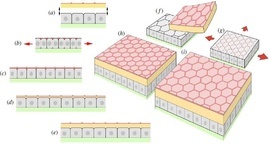Understanding ecdysis in Early Cambrian Scalidophoran Worms.
[sciencythoughts.blogspot.com]
The epidermis is a fundamental cellular tissue of Metazoans (Animals) which acts as an interface between the external medium and the body interior. It includes epithelial cells and extracellular material. Epithelial cells form a tissue with complex junction systems and secrete two types of extracellular substrates: basally, the extracellular matrix, and apically, the glycocalyx (layers of proteins and sugar) and the cuticle. Although absent in Placozoans and Ctenophores, the glycocalyx plays a crucial role as a matrix on which other extracellular molecules (e.g. chitin, collagen) can anchor and eventually form a cuticular structure. A cuticle occurs in all present-day Ecdysozoans (Nematoida, Scalidophora, Panarthropoda), with a consistent three-layered structure. Ecdysozoans display a great variety of cuticular structures often associated with sensory organs (e.g. setae). Cuticular moulting is common to all extant representatives of Ecdysozoa and is a key diagnostic feature of the group. Exuviae found in early Cambrian Scalidophoran worms from China (roughly 535 million years old) suggest that ecdysis has a very ancient origin and evolves through a suite of genetic innovations in the three Ecdysozoans clades (Scalidophora, Nematoida, Panarthropoda).



Enjoy being online again!
Welcome to the community of good people who base their values on evidence and appreciate civil discourse - the social network you will enjoy.Create your free account
Recent Visitors 19
Lucy_Fehr
Fort Pierce,
Fernapple
UK
AnneWimsey
Groton,
Triphid
Broken Hill,
JackPedigo
Lopez Island,
Photos 292 More
Posted by JoeBKite-like structures in the western Sahara Desert.
Posted by TriphidAn Aussie Indigenous Message Stick.
Posted by TriphidIndigenous Australian Aboriginal Rock art dated somewhere between 20 and 30 thousand years old.
Posted by TriphidIndigenous Australian Aboriginal Rock art dated somewhere between 20 and 30 thousand years old.
Posted by TriphidIndigenous Australian Aboriginal Rock art dated somewhere between 20 and 30 thousand years old.
Posted by TriphidIndigenous Australian Aboriginal Rock art dated somewhere between 20 and 30 thousand years old.
Posted by JoeBDortoka vremiri: A new species of Dortokid Turtle from the Late Cretaceous of the Hațeg Basin, Romania.
Posted by JoeBThe Cabeço da Amoreira burial: An Early Modern Era West African buried in a Mesolithic shell midden in Portugal.
Posted by JoeBMusivavis amabilis: A new species of Enantiornithine Bird from the Early Cretaceous Jehol Biota of northeastern China.
Posted by JoeBTorosaurus in Canada.
Posted by JoeBStone tools from the Borselan Rock Shelter, in the Binalud Mountains of northeastern Iran.
Posted by JoeBDating the Lantian Biota.
Posted by JoeBBashanosaurus primitivus: A new species of Stegosaur from the Middle Jurassic of Chongqing Municipality, China.
Posted by JoeBDetermining the time of year when the Chicxulub Impactor fell.
Posted by JoeBSão Tomé and Príncipe: Possibly the last country on Earth never to have been visited by a working archaeologist.
Posted by JoeBMambawakale ruhuhu: A new species of Pseudosuchian Archosaur from the Middle Triassic Manda Beds of Tanzania.
Members 658Top
Moderator
Related GroupsMore
Religion of Science & Higher Consciousness
77 members
Political Posts, Articles and Memes
169 members
"I was blocked!?" Group
95 members
Conservative Bashers And Progressive Pushers
136 members
Trump Pinata
1142 members
Out Of The Illusion
1742 members
FreeThinkers
2693 members
Progressives, Socialists, and Black/Palestinian Lives Matter
2460 members





